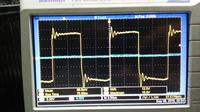mrinalmani
Advanced Member level 1
- Joined
- Oct 7, 2011
- Messages
- 463
- Helped
- 60
- Reputation
- 121
- Reaction score
- 58
- Trophy points
- 1,318
- Location
- Delhi, India
- Activity points
- 5,285
Am MOSFET inverter (H-Bridge) is giving power loss of 4W even without a load.
The details are given below:
V = 12V
F = 100KHz
MOSFET Rds = 1mOhm
The gate input to all the MOSFETS are absolutely clean with almost no overshoot, gate voltage is 10V.
When I connected only the lower two MOSFETs, and gave the input signal, the current drawn by the 12V battery was 90mA, including driver current.
When I connected the upper two MOSFETs also, the current increased to 350mA (average).
I have also blown off a few upper MOSFETs by over heating.
Oscilloscope readings show pulse current as high as 15A during switching. However, there is little possibility of shoot-through as the dead band is 1uS and driver rise time is only 185nS.
Also since the internal resistance is only 1mOhm, even a continuous 15A would cause negligible heating, forget about pulses. Some where or the other both voltage and current are occouring simultaneously. But why? There doesnt seem to be a good reason... Where is this current pulse arising from?

(Output waveform)


(Voltage blue, current yellow)
Please help!
The details are given below:
V = 12V
F = 100KHz
MOSFET Rds = 1mOhm
The gate input to all the MOSFETS are absolutely clean with almost no overshoot, gate voltage is 10V.
When I connected only the lower two MOSFETs, and gave the input signal, the current drawn by the 12V battery was 90mA, including driver current.
When I connected the upper two MOSFETs also, the current increased to 350mA (average).
I have also blown off a few upper MOSFETs by over heating.
Oscilloscope readings show pulse current as high as 15A during switching. However, there is little possibility of shoot-through as the dead band is 1uS and driver rise time is only 185nS.
Also since the internal resistance is only 1mOhm, even a continuous 15A would cause negligible heating, forget about pulses. Some where or the other both voltage and current are occouring simultaneously. But why? There doesnt seem to be a good reason... Where is this current pulse arising from?

(Output waveform)


(Voltage blue, current yellow)
Please help!